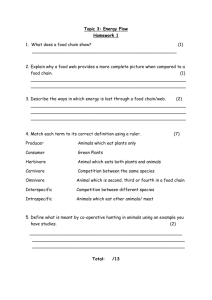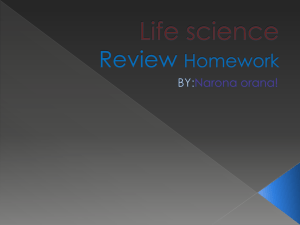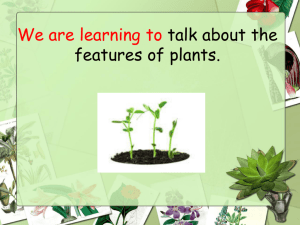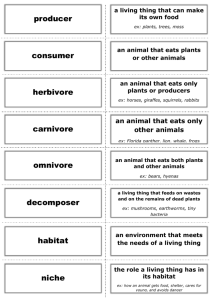Life science review
advertisement
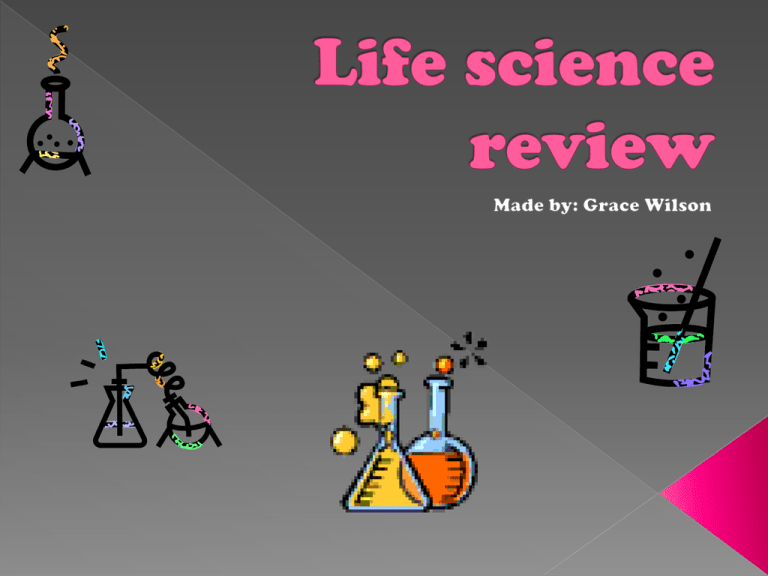
Draw and label the water cycle. Condensation Evaporation Participation Trancepirtation Run Off Accumulation What happens during condensation? Does Earth only experience condensation in the clouds? Why or Why not. Condensation happens when water vapor turns into water droplets. Condensation doesn't only happen in the clouds. I know that because we always see condensation on our drinks. Draw and label a diagram of the carbon dioxide / oxygen cycle. Write what would happen if we had too many of a type of organism. CO2 Oxygen producer consumers Describe the differences between inherited traits vs. learned behaviors. Give 5+ examples of each. Learned Traits: traits that don’t come naturally and have to be learned. Examples: a horse jumping poles, a human reading, how to make a PowerPoint, how to hunt, and how to write. Inherited Traits: traits that you are born with (instinct) Examples: birds migrate, brown eyes, hair color, sea turtles go to the same place they were born to give birth, right or left handed, and glasses or no glasses. Producer: something that makes it’s own nutrients Examples: Trees, Flowers,Bushes, and Moss Define the following & give at least two examples of each. -Producer -Consumer -Decomposer -Herbivores -Carnivores -Omnivores -Scavenger -Niche Continued to the next page. Consumers: something that eats an oyher organism to get it’s nutrients Example: Fox, Coyote , Squirrel, and cow Decomposers: a animal that breaks down dead things for nutrients. Examples: Fungi, and mushrooms Herbivores: an animal that eats plants for nutrients Examples: Rabbits, Horses, and Ducks. Omnivores: an animal that eats both plants and meat for nutrients. Examples: Bear, Skunk, and Possum Carnivores an animal that eats meat for it’s nutrients. Examples: Shark, Lion, and Wolves. Scavengers: a carnivore that eats the scraps of a other carnivores meal for nutrients. Examples :Hyena, Vulture, and Tasmanian Devil Niche a part that an organism has in it’s environment. Example: Decomposer, producer, and carnivore. How are the teeth different of a herbivore vs. a Carnivore? Can they decide one day to change their diet? Why? Herbivore teeth: flat, had and not sharp. Carnivore teeth: sharp teeth to rip into food. Animals could not just change their diet because their teeth aren’t made for that type of food. Put the following food chains in the right order & identify the following organisms as producer, consumer, predator, prey, or scavenger. #1: Seal, seaweed, polar bear, sun. #2: Hawk, sun, rabbit, grass, vulture. #1: Sun, Seaweed, Seal, Polar Bear Seaweed: Producer Seal: Consumer, Prey Polar Bear: Consumer, Predator #2: Sun, Grass, Rabbit, Hawk, Vulture Grass: Producer Rabbit: Consumer, Prey Hawk: Consumer, Predator Vulture: Scavenger List 4 different possibilities that would happen if on of the organisms in the food chains ( #7 ) died out. 1. If seaweed died out then the seals would die out. 2. If seals died out then Polar bears would die out. 3. If hawks died out then the rabbits would over populate. 4. If the Vulture died out then there would be a lot of dead things lying around. Define and list the simularities and differences between complete metamorphisis and incomplete metamorphisis ** Be sure to draw an example of an animals metamorphisis for each stage. See paper below. Describe the function/purpose of each plant part: seed, flower, leaf, stem, root. Seed: the way plants reproduce Flower: creates seeds to reproduce Stem: keeps the plant upright amnd water goes up and down it Root: holds the plant in place, holds nutrients, for food. Leaves: Make the food for the plant. Do all the plants need the same amount of sunlight, water, and nutrients in the soil? Explain with examples. No, because the cactus doesn't need as much water as a brad fruit pear because it has adapted to the conditions to its dry desert home. List the 3 ways seeds mainly travel. Include pros and cons for seeds being able to travel. Seeds travel by; 1. Wind 2. Water 3. Animals The pro of seeds being able to travel is that the plant can spread seeds. The con is that the seeds could be hurt along the way. List 4+ possibilities of how a plant population would decrease Plants in a ecosystem could decrease if…….. 1. Humans and animals ate all their seeds 2. People cut them down for buildings 3. There were no pollinators to help flowers reproduce 4. People and animals ate to many of that type of plant Choose an animal that lives in a desert and describe 3 adaptations. I choose a Thorny Devil 1. Has a special pattern with it’s scales that make water flow to it’s mouth. 2. Tail looks like head. 3. Blends in. Describe how a cactus adapts and its niches in its environment. Cactus’ adaptations: Thorns and doesn't need a lot of water. Cactus’ niches (jobs): producer, Home for animals, and food. Describe a Deciduous Forest biome in detail with pictures. Include plants , animals, amount of sunlight, spacing etc…….. = Blends in, and lives in a burrow = Leaves change color and then fall off to minimize water loss. Moderate sunlight year long Describe a tundra biome & the organisms in it. Include plant and animal adaptations for survival. The tundra biome is like a cold desert. Polar Bear: Lots of fur, padded paws, and can swim. Grass: hug the ground
